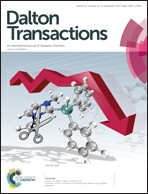Reactivity of kiteplatin with S-donor biomolecules and nucleotides†
Abstract
Kiteplatin, (cis-1,4-DACH)dichloridoplatinum(II), contains an isomeric form of the carrier ligand present in the successful antitumor drug oxaliplatin and has been recently found to be very active against oxaliplatin-resistant colon cancers, confirming that, by changing the nature of the amine ligand, it is possible to obtain platinum drugs that are not cross-resistant to those already in clinical use. Apart from interaction with DNA, another factor that can affect the activity of platinum drugs is their metabolic fate in the cellular environment. Therefore, kiteplatin has been reacted with S-donor biomolecules, such as glutathione, cysteine, and methionine. The investigation has further confirmed the different reactivity of methionine as compared to cysteine-containing peptides and has unraveled the possibility of cis-1,4-DACH to become mono-coordinated with one free end (a situation never seen for isomeric 1,2-DACH ligands) and to labilize cis ligands as a consequence of its large steric hindrance. The reaction of kiteplatin–GSH adducts with 5′-GMP has also shown how the reaction products can be different depending upon the aerobic or anaerobic reaction conditions used.


 Please wait while we load your content...
Please wait while we load your content...